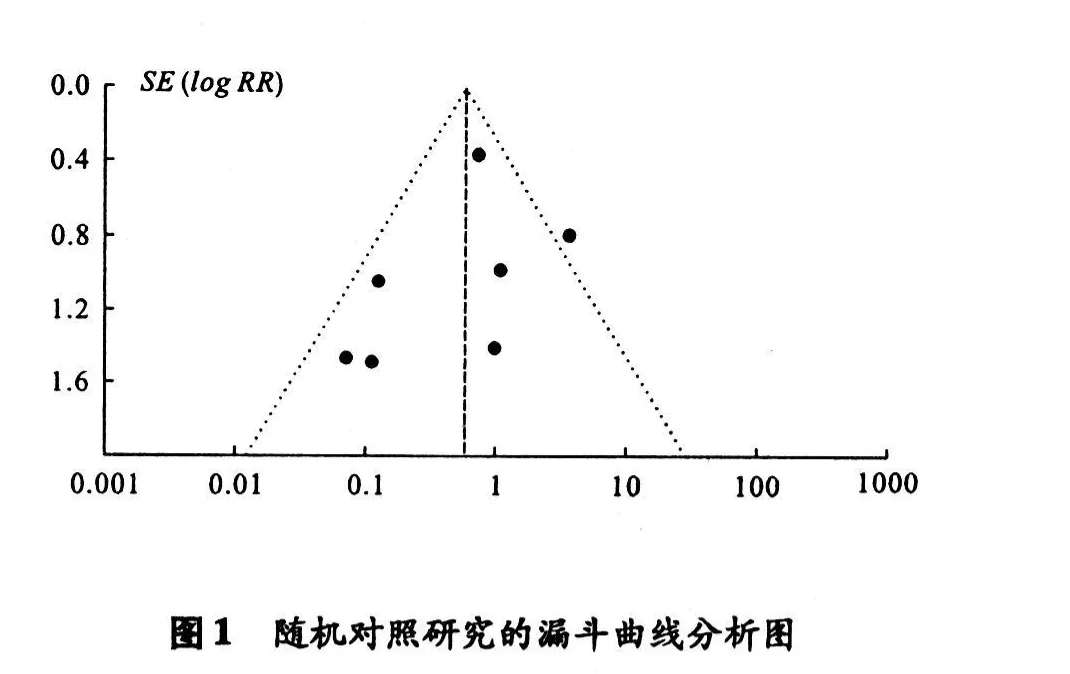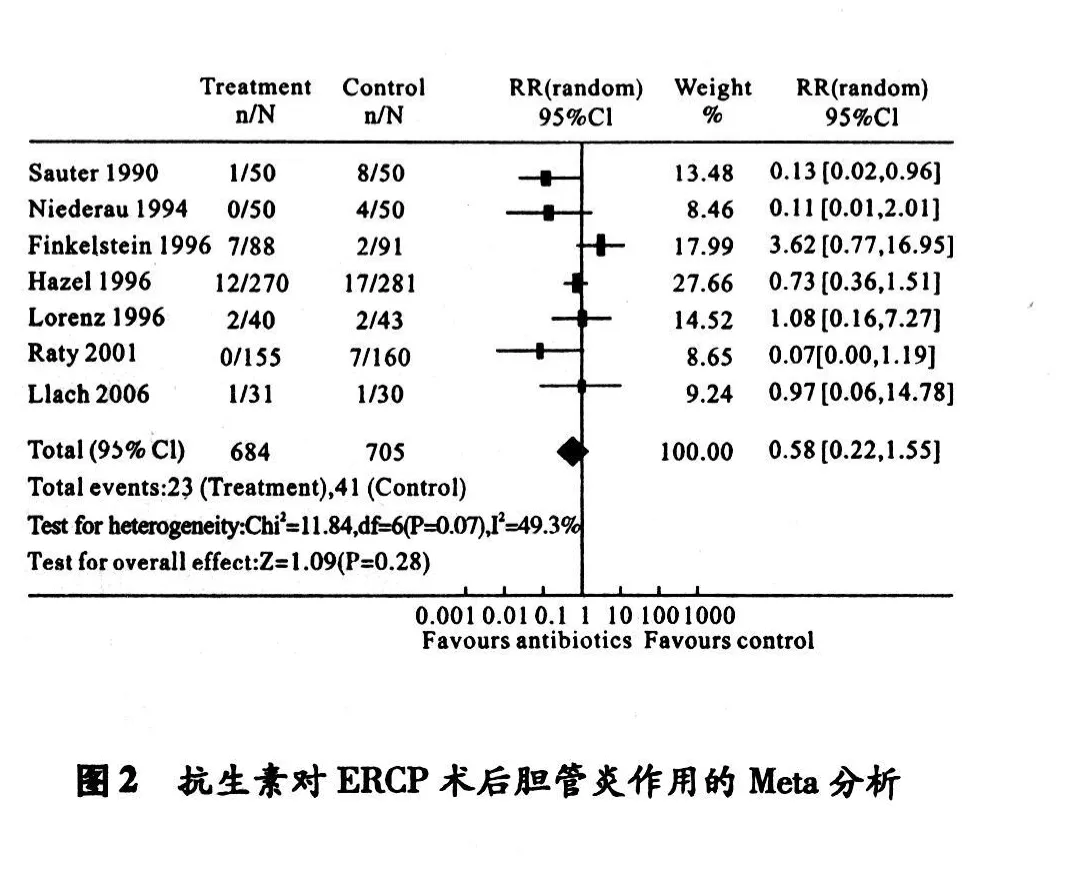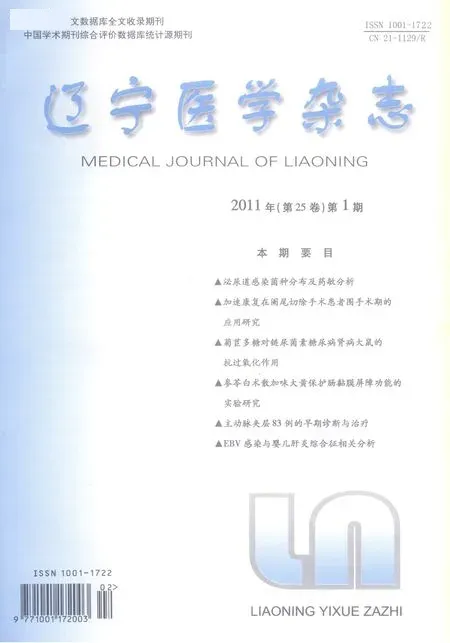ERCP术前应用抗生素防治胆管炎的荟萃分析
沈阳军区总医院内窥镜科(110016) 高 飞 麻树人 张 宁
感染是内镜逆行胰胆管治疗(ERCP)最常见的并发症之一,病死率达 10%[1],多个大样本的研究显示其发生率为 0.87%~1.0%[2-3]。胆管炎的主要诱因是胆道梗阻引起的黄疸和胆道不充分引流[3-4]。因此,美国消化内镜协会推荐胆管梗阻的患者 ERCP术前常规应用抗生素[5]。然而,美国心脏协会最新制定的指南指出即使伴有胆管阻塞的患者ERCP术前也不建议应用抗生素[6],已往的一项Meta分析结果表明,治疗组和对照组的 ERCP术后败血症的发生率无显著差异[7]。此后的许多研究结果也不一致[8-9],因此,有必要通过对相关的随机对照研究进行分析,探讨 ERCP术前应用抗生素在术后胆管炎/败血症中的预防性作用。
1 材料与方法
计算机检索 MEDLINE数据库、EMBASE数据库、Cochrane数据库和 Science Citation Index。采集2007年 6月前的所有相关文献及参考目录中的引用文献。纳入标准:1)随机对照实验(RCT)。2)研究对象:ERCP治疗的患者。3)干预:预防性应用抗生素。4)研究指标:ERCP术后发生胆管炎或败血症。
由 2名作者共同制定统一表格并各自独立地对入选研究按照治疗组和对照组的结果进行资料摘录。所有数据录入 Review Manager系统(Version 4.2 for Windows,Cochrane Collaboration,Oxford,UK,2002)。应用 Cochrane协作网提供的 Revman 5.0软件,计算 OR及 95%CI,若异质性 Q检验显示差异无统计学意义,选用固定效应模型;反之,则采用随机效应模型。通过漏斗曲线判断文献是否存在偏差[10]。为进一步验证临床异质性,我们设计了两种敏感性分析。一是评价静脉注射抗生素组与其他给药方式组之间有无差异。二是评价胆管阻塞组与随机组之间有无差异。
2 结 果
共检索到相关文献 86篇,通过阅读文献题目、摘要和全文,排除未达到纳人标准的文献最终纳入7篇 RCT文献[8-9,11-15]。通过漏斗曲线分析(见图1),我们认为,纳入的文献可能存在发表偏见。纳入研究的异质性 Q检验显示差异有显著性(P<0.05),采用随机效应模型进行 Meta分析(见图 2)。


预防性应用抗生素和 ERCP术后胆管炎或败血症发生率的分析总计 7项研究、1389例患者入选(见图 2)。Meta分析结果证实,对照组和治疗组ERCP术后胆管炎或败血症的发生率分别是 5.8%(41/705)和 3.4%(23/684),两者差异无显著性(RR=0.58;95%CI:0.22~1.55)。
关于敏感性分析,Hazel[4]和 Räty[8]等人针对怀疑胆道梗阻的患者进行研究,结果证实,治疗组和对照组 ERCP术后胆管炎或败血症的发生率分别是2.8%(12/425)和 5.4%(24/441)。该结果表明,术前应用抗生素无预防胆管炎的作用(P=0.35,RR=0.33;95%CI:0.03,3.32)。 Llach等人[9]发表的唯一一项肌肉注射抗生素的研究证实,治疗组和对照组 ERCP术后胆管炎或败血症的发生率分别是 3.4%(22/653)和 5.9%(40/675),该结果也表明,抗生素无胆管炎的预防作用(P=0.26,RR=0.53;95%CI:0.18,1.60)。
3 讨 论
本研究进一步证实,预防性应用抗生素不能降低 ERCP术后并发胆管炎的发生率。因此,不建议ERCP术前常规应用抗生素。然而,对于有胆道梗阻的患者,尚缺乏足够证据证明是否可以预防性应用抗生素。此外,由于阴性结果的研究发表较少,因此本研究存在一定的偏差。
ERCP已经广泛应用于胆胰疾病的诊断和治疗,胆管炎是其最常见的并发症之一[16-17]。发生胆管炎的主要原因是胆系感染或阻塞导致的胆汁排泄不畅。因此,促进胆汁排泄通畅和药物治疗能降低胆管炎和其他感染性并发症的发生率。虽然如此,术前应用抗生素对预防 ERCP术后胆管炎的作用仍有争议。
事实上,Harris[7]等人的 Meta分析结果证实,治疗组的菌血症发生率明显低于对照组,但败血症发生率无明显差异。他们的研究也首次提出,中度危险因素患者应用抗生素对胆管炎的发生无预防作用。但是,目前仍不清楚对于高危患者应用抗生素是否有效。目前仅有 Hazel等人[14]的一项对于可疑胆道梗阻患者的研究结果显示,预防性应用抗生素并没有显著效果,而 ERCP诊断证实 20%的纳入对象没有胆道梗阻。另外一项 Räty[8]等人针对可疑胆总管结石患者的研究提示,治疗组患者均未并发胆管炎,而 4.4%(7/160)的对照组患者并发胆管炎,两组之间差异有显著性(P=0.009)。然而,值得注意的是该研究对象不包含高危因素的患者,近 30%(96/315)的研究对象不存在胆道梗阻。Cotton[18]等人经过 11年的研究总结限制性应用抗生素能很大程度上降低 ERCP并发感染,只有胆汁引流不畅或免疫抑制的患者需要预防性应用抗生素。
本研究显示,治疗组 ERCP术后胆管炎的 RR值为 0.58,表明胆管炎的发生率降低 42%。对照组ERCP术后胆管炎的 RR值为 0.33,表明胆管炎的发生率降低 67%。然而,两组之间差异无显著性。根据本研究和纳入文献的结果分析,我们建议对肝门部胆管癌及原发性硬化性胆管炎等瘀胆型疾病与胆总管结石等胆汁引流充分的疾病要谨慎区别对待。多个前瞻性的研究也表明,肝门部恶性狭窄患者行内镜下胆管支架置入术并发感染性疾病的发生率为 10%~18%[19-20]。同样,Hazel等人[14]和 Räty等人[8]进行的大样本研究表明,胆总管结石患者行ERCP治疗术后胆管炎的发生率为 4.4%~6.0%。也就是说淤胆型患者比胆汁排泄通畅患者更易发生ERCP术后胆管炎。随后的较多类似研究也证实了这一情况,而且胆汁引流不充分的患者术前应用抗生素是否能预防 ERCP术后胆管炎的发生仍不能明确,因此应用抗生素的最佳时间应该是 ERCP术后3~5天。
总之,本研究表明预防性应用抗生素不能显著降低 ERCP术后胆管炎的发生率,因此不推荐临床ERCP术前常规应用抗生素。
[1] BilbaoMK,Dotter CT,Lee TG,etal.Complicationsofendoscopic retrograde cholangiopancreatography A study of 10,000 cases[J].Gastroenterology,1976,70:314
[2] Freeman M,Nelson D,Sherman S,et al.Complications of endoscopic biliary sphincterotomy[J].N Engl JMed,1996,335:909
[3] Loperfido S,Giampaolo A,Benedetti G,et al.Major early complications from diagnostic and therapeutic ERCP:a prospective multicenter study[J].Gastrointest Endosc,1998,48:1
[4] Vaira D,D'Anna L,Ainley C,et al.Endoscopic sphincterotomy in 1000 consecutive patients[J].Lancet,1989,II:431
[5] Hirota WK,Petersen K,Baron TH,et al.Standards of practice committee of the american society for gastrointestinal endoscopy.Guidelines for antibiotic prophylaxis for g Iendoscopy[J].Gastrointest Endosc,2003,58:475
[6] WilsonW,TaubertKA,GewitzM,etal.American heart association rheumatic fever,endocarditis and kawasaki disease committee,council on cardiovascular disease in the young;council on clinical cardiology;council on cardiovascular surgery and anesthesia;quality of care and qutcomes research interdisciplinary working group.prevention of infective endocarditis:guidelines from the american Heart association:a guideline from the american heart as-sociation rheumatic fever,endocarditis and kawasakidisease committee,council on cardiovascular disease in the young,and the council on clinical cardiology,council on cardiovascular surgery and anesthesia,and the quality of care and qutcomes research interdisciplinary working group[J].JAm Dent Assoc,2007,138:739
[7] Harris A,Chan AC,Torres-Viera C,et al.Meta-analysis of antibiotic prophylaxis in endoscopic retrograde cholangiopancreatography(ERCP)[J].Endoscopy,1999,31:718
[8] Räty S,Sand J,Pulkkinen M,et al.Post-ERCP pancreatitis:reduction by routine antibiotics[J].J Gastrointest Surg,2001,5:339
[9] Llach J,Bordas JM,Almela M,et al.Prospective assessment of the role of antibiotic prophylaxis in ERCP[J].Hepatogastroenterology,2006,53:540
[10] Begg,CB.Publication bias in H cooper&L.V.hedges(Eds)[M].The handbook of research synthesis:New York:Russell Sage Foundation,1994:399
[11] Sauter G,Grabein B,Huber G,et al.Antibiotic prophylaxis of infectious complications with endoscopic retrograde cholangiopancreatography.A random ized controlled study[J].Endoscopy,1990,22:164
[12] Niederau C,Polmann U,Lubke H,et al.Prophylactic antibiotic treatment in therapeutic or complicated diagnostic ERCP:Results of a randomized controlled clinical study[J].GastrointestEndosc,1994,40:533
[13] Finkelstein R,Yassin K,Suissa A,et al.Failure of cefonicid prophylaxis for infectious complications related to endoscopic retrograde cholangiopancreatography[J].Clin Infect Dis,1996,23:378
[14] Hazel SJ,Speelman P,Dankert J,et al.Piperacillin to prevent cholangitis after endoscopic retrograde cholangiopancreatography.A random ized,controlled trial[J].Ann Intern Med,1996,125:442
[15] Lorenz R,Lehn N,Born P,et al.Antibiotic prophylaxis using cefuroxime in bile duct endoscopy[J].Dtsch Med Wochenschr,1996,121:223
[16] Low DE,Mieflikier AB,Kennedy JK,et al.Infectious complications ofendoscopic retrograde cholangiopancreatography A prospective assessment[J].Ann Intern Med,1980,140:1076
[17] Stray N,Midtvedt T.Endoscopy related bacteremia[J].Scand J Gastroenterol,1978,13:345
[18] Cotton PB,Connor P,Rawls E,et al.Infection after ERCP and antibiotic prophylaxis:a sequential quality-improvement approach over 11 years[J].GastrointestEndosc,2008,67:471
[19] Polydorou AA,Cairns SR,Dowsett JF,et al.Palliation of proximalmalignant biliary obstruction by endoscopic endoprosthesis insertion[J].Gut,1991,32:685
[20] De Palma GD,Galloro G,Siciliano S,et al.Unilateral versus bilateral endoscopic hepatic duct drainage in patients with malignant hilar biliary obstruction:results of a prospective,randomized,and controlled study[J].Gastrointest Endosc,2001,53:547

